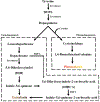Pharmacologic manipulation of skin pigmentation
- PMID: 33666358
- PMCID: PMC8277713
- DOI: 10.1111/pcmr.12969
Pharmacologic manipulation of skin pigmentation
Abstract
Skin complexion is among the most recognizable phenotypes between individuals and is mainly determined by the amount and type of melanin pigment deposited in the epidermis. Persons with dark skin complexion have more of a brown/black pigment known as eumelanin in their epidermis whereas those with fair skin complexions have less. Epidermal eumelanin acts as a natural sunblock by preventing incoming UV photons from penetrating into the skin and therefore protects against UV mutagenesis. By understanding the signaling pathways and regulation of pigmentation, strategies can be developed to manipulate skin pigmentation to improve UV resistance and to diminish skin cancer risk.
Keywords: cAMP; melanin; melanocortin 1 receptor; melanocyte; pigmentation.
© 2021 John Wiley & Sons A/S. Published by John Wiley & Sons Ltd.
Conflict of interest statement
Ethics and integrity: The authors declare no conflicts of interest. There are no reproduced materials from other sources.
Figures

Similar articles
-
Topical treatment strategies to manipulate human skin pigmentation.Adv Drug Deliv Rev. 2020 Jan 1;153:65-71. doi: 10.1016/j.addr.2020.02.002. Epub 2020 Feb 21. Adv Drug Deliv Rev. 2020. PMID: 32092380 Free PMC article.
-
Pharmacologic induction of epidermal melanin and protection against sunburn in a humanized mouse model.J Vis Exp. 2013 Sep 7;(79):50670. doi: 10.3791/50670. J Vis Exp. 2013. PMID: 24056496 Free PMC article.
-
Chemical analysis of constitutive pigmentation of human epidermis reveals constant eumelanin to pheomelanin ratio.Pigment Cell Melanoma Res. 2015 Nov;28(6):707-17. doi: 10.1111/pcmr.12410. Epub 2015 Sep 22. Pigment Cell Melanoma Res. 2015. PMID: 26285058
-
Was skin cancer a selective force for black pigmentation in early hominin evolution?Proc Biol Sci. 2014 Feb 26;281(1781):20132955. doi: 10.1098/rspb.2013.2955. Print 2014 Apr 22. Proc Biol Sci. 2014. PMID: 24573849 Free PMC article. Review.
-
Variation in melanin content and composition in type V and VI photoexposed and photoprotected human skin: the dominant role of DHI.Pigment Cell Res. 2001 Oct;14(5):337-47. doi: 10.1034/j.1600-0749.2001.140505.x. Pigment Cell Res. 2001. PMID: 11601655
Cited by
-
Similar Diameter of Cutaneous Branches of the Proper Digital Nerve and Stump of the Proper Palmar Digital Nerve was a Key Factor for the Sensory Reconstruction in Short Term Outcome of Finger Pulp Defects: A Retrospective Study.Orthop Res Rev. 2025 Aug 15;17:391-399. doi: 10.2147/ORR.S533750. eCollection 2025. Orthop Res Rev. 2025. PMID: 40837823 Free PMC article.
-
An In Vitro Strategy to Evaluate Ketoprofen Phototoxicity at the Molecular and Cellular Levels.Int J Mol Sci. 2024 Nov 25;25(23):12647. doi: 10.3390/ijms252312647. Int J Mol Sci. 2024. PMID: 39684359 Free PMC article.
-
Isolated knuckle hyperpigmentation associated with bosutinib.BMJ Case Rep. 2024 Feb 27;17(2):e258536. doi: 10.1136/bcr-2023-258536. BMJ Case Rep. 2024. PMID: 38417948 No abstract available.
-
Antimelanogenesis Effects of Theasinensin A.Int J Mol Sci. 2021 Jul 12;22(14):7453. doi: 10.3390/ijms22147453. Int J Mol Sci. 2021. PMID: 34299073 Free PMC article.
-
Generating Functional and Highly Proliferative Melanocytes Derived from Human Pluripotent Stem Cells: A Promising Tool for Biotherapeutic Approaches to Treat Skin Pigmentation Disorders.Int J Mol Sci. 2023 Mar 29;24(7):6398. doi: 10.3390/ijms24076398. Int J Mol Sci. 2023. PMID: 37047372 Free PMC article.
References
-
- Abdel-Malek ZA, Kadekaro AL, Kavanagh RJ, Todorovic A, Koikov LN, McNulty JC, … Knittel JJ (2006). Melanoma prevention strategy based on using tetrapeptide alpha-MSH analogs that protect human melanocytes from UV-induced DNA damage and cytotoxicity. FASEB J, 20(9), 1561–1563. doi:fj.05-5655fje [pii] - PubMed
-
- Abdel-Malek ZA, Ruwe A, Kavanagh-Starner R, Kadekaro AL, Swope V, Haskell-Luevano C, … Knittel JJ (2009). alpha-MSH tripeptide analogs activate the melanocortin 1 receptor and reduce UV-induced DNA damage in human melanocytes. Pigment Cell Melanoma Res, 22(5), 635–644. doi:10.1111/j.1755-148X.2009.00598.x - DOI - PubMed
-
- Barnetson RS, Ooi TK, Zhuang L, Halliday GM, Reid CM, Walker PC, … Kleinig MJ (2006). [Nle4-D-Phe7]-alpha-melanocyte-stimulating hormone significantly increased pigmentation and decreased UV damage in fair-skinned Caucasian volunteers. J Invest Dermatol, 126(8), 1869–1878. - PubMed
-
- Bautista RM, Carter KM, Jarrett SG, Napier D, Wakamatsu K, Ito S, & D’Orazio JA (2020). Cutaneous pharmacologic cAMP induction induces melanization of the skin and improves recovery from ultraviolet injury in melanocortin 1 receptor-intact or heterozygous skin. Pigment Cell Melanoma Res, 33(1), 30–40. doi:10.1111/pcmr.12817 - DOI - PMC - PubMed
Publication types
MeSH terms
Substances
Grants and funding
LinkOut - more resources
Full Text Sources
Other Literature Sources
Medical

